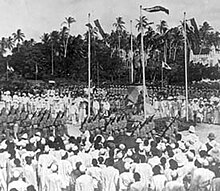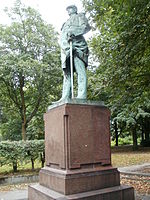Adolf Kürle
Adolf Kürle (born March 20, 1865 in Cassel , † April 6, 1912 in Berlin ) was a German sculptor and painter who mainly worked in Berlin.
Life
Kürle was trained in Kassel and initially worked mainly as a portrait painter. In 1896 he was involved in the 30th large painting exhibition of the Kunstverein Bremen . Later on, sculpture came to the fore.
Adolf Kürle died in Berlin in 1912 at the age of 47 and was buried in the Dahlem cemetery. The grave has not been preserved.
plant
In 1901 the magazine Berliner Architekturwelt presented his group of figures "Dorothea". It showed a barefoot girl who was carrying a jug in her hanging right hand and was tugging at his knee-length robe by a small dog, and was intended, for example, to decorate a public facility or a fountain. Kürle had shown this work in 1900 at the Great Berlin Art Exhibition .
Works in public space
Wissmanndenkmal

On April 3, 1909, Kürle's monument to the Africa explorer Hermann von Wissmann, who died in 1905, was inaugurated in Dar es Salaam . The master stonemason L. Niggl from Breslau supplied the designed sandstone plinth . It showed the statue of the colonial official, stylized as a “great African” in Germany, in a martial pose leaning on his rifle. After the end of German colonial rule, the memorial was transported to Great Britain, in 1921 it came to Germany, where it was initially to be erected in Berlin , but was then given a place in Hamburg in front of a university institute. In the time of National Socialism , Wissmann was regarded as a symbolic figure of German expansionist efforts. Towards the end of the Second World War , the statue fell from its base during a bombing, on which it was placed again in 1949. From 1961 onwards there was a protest against the monument, in which one increasingly perceived a glorification of colonial rule. In 1968 students toppled the statue from its pedestal, whereupon it was stored in the Hamburg-Bergedorf observatory , from which it has only been taken out for exhibition purposes ever since.
Colonial War Memorial
In 1909, the commander-in-chief of the protection forces, Ludwig von Estorff, commissioned the sculptors Hans Weddo von Glümer , Kürle, Otto Riesch and Albert Moritz Wolff to create designs for a colonial war memorial for Windhoek . Kürle's design, which showed an armed rider from the Schutztruppe on horseback, was executed in bronze in Berlin and then brought to Windhoek by ship. The depiction of a simple soldier on horseback was unusual. Up until now, equestrian monuments had shown emperors, kings or princes in this pose instead of anonymous fighters. A plaque with the following inscription was attached to the memorial: “In honor of the brave German warriors who lost their lives for the emperor and empire to save and preserve this country during the Herero and Hottentot uprisings from 1903 to 1907 and during the Kalahari expedition in 1908. In honor of the memory of the German citizens who fell victim to the natives in the uprising. Fallen, missing, had an accident, killed their wounds and died of diseases, from the Schutztruppe: officers 100, NCOs 254, riders 1180, from the Navy: officers 7, NCOs 13, crews 72, slain in the uprising: men 119, women 4, Children 1. “ From January 27, 1912 to August 2009, the memorial stood on a square that was then to be used for the new Independence Memorial Museum , after which it was moved in front of the Alte Feste .
Bismarck Monument
Another monument by Kürle's hand is the Bismarck monument in Schleepark in Hamburg-Altona . It shows Bismarck standing, the spiked bonnet on his head and his left hand resting on a saber.
literature
- Birthe Kundrus , Modern Imperialists. The Empire in the Mirror of its Colonies , Böhlau 2003, ISBN 978-3412187026 , pp. 210-218
Web links
Individual evidence
- ^ Ludwig Arndt, Military Associations in Northern Germany. Club life, badges, awards, monuments , BoD 2008, ISBN 978-3833489662 , p. 252
- ↑ http://www.stern.de/politik/geschichte/herero-aufstand-sturm-ueber-deutsch-suedwest-518364.html
- ^ Directory of the exhibition catalogs of the Kunsthalle Bremen / 1829-2004. Kunstverein in Bremen, archived from the original on July 19, 2011 ; accessed on March 17, 2014 .
- ^ Hans-Jürgen Mende: Lexicon of Berlin burial places . Pharus-Plan, Berlin 2018, ISBN 978-3-86514-206-1 , p. 570.
- ↑ http://opus.kobv.de/zlb/volltexte/2006/470/pdf/BAW_1901_04.pdf
- ↑ Winfried Speitkamp: The cult of the dead around the colonial heroes of the German Empire ; in: zeitenblicke 3 (2004), No. 1 (PDF; 101 kB), accessed on August 18, 2010
- ^ C. Gäbert, A. Steuer, Karl Weiss: The usable rock deposits in Germany . Berlin (Union Deutsche Verlagsgesellschaft) 1915, pp. 130–131
- ↑ http://www.afrika-hamburg.de/denkmal.html
- ^ Carl Möbius (1876 Borna to 1953 Berlin) ( Memento from March 17, 2014 in the Internet Archive )
- ↑ https://web.archive.org/web/20090218182057/http://www.az.com.na/lokales/status-und-zukunft-des-reiterdenkmals-and-eine-denkschrift-teil-1.68493.php
- ↑ The rider should go! In: German voice. November 4, 2009, archived from the original on September 15, 2011 ; accessed on March 18, 2014 .
- ↑ http://www.afrika-hamburg.de/fragesafari6.htm
- ↑ http://www.hamburg.citysam.de/fotos-hamburg/schleepark-altona-2.htm
| personal data | |
|---|---|
| SURNAME | Kürle, Adolf |
| BRIEF DESCRIPTION | German sculptor and painter |
| DATE OF BIRTH | March 20, 1865 |
| PLACE OF BIRTH | Cassel |
| DATE OF DEATH | April 6, 1912 |
| Place of death | Berlin |

